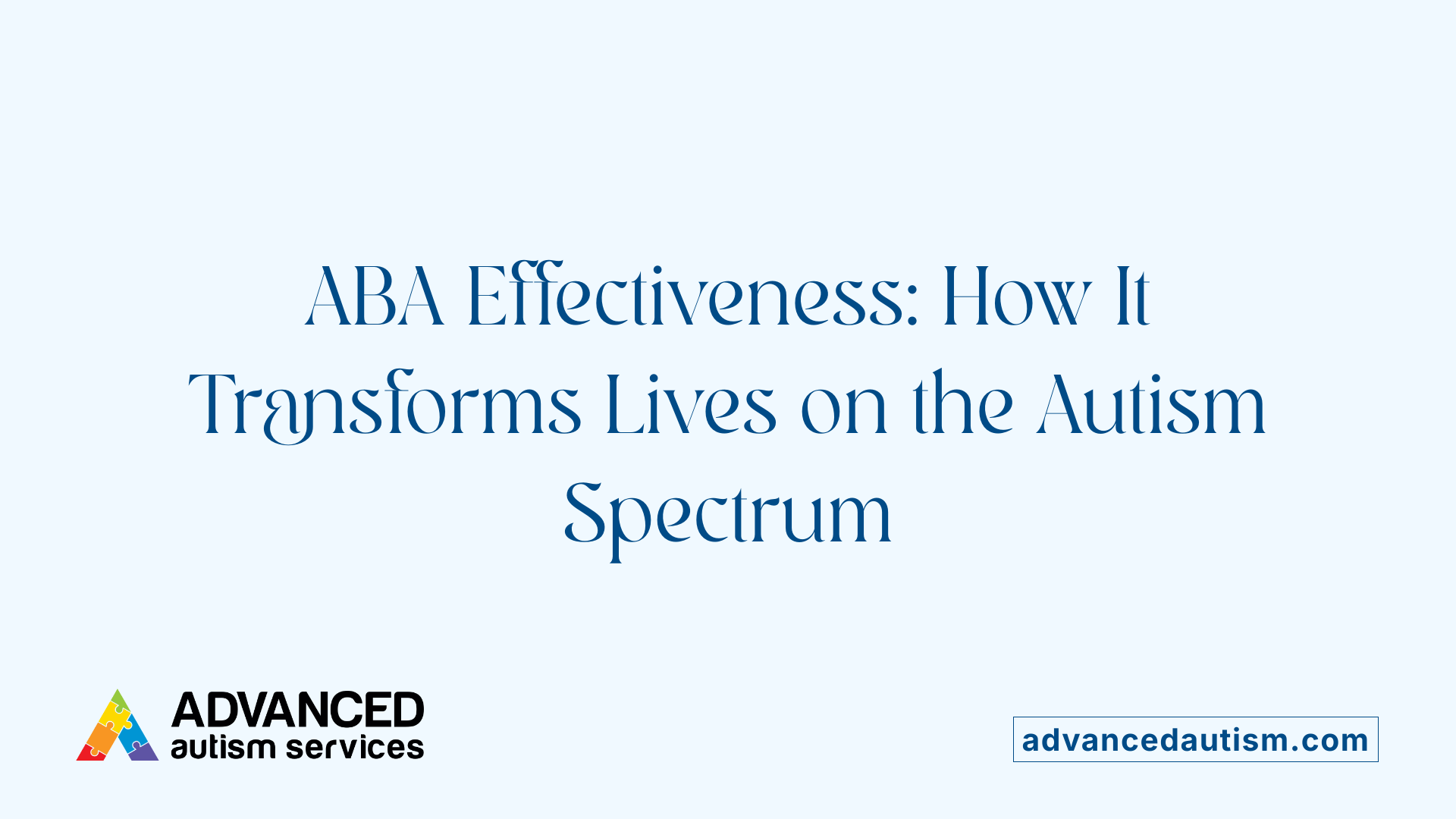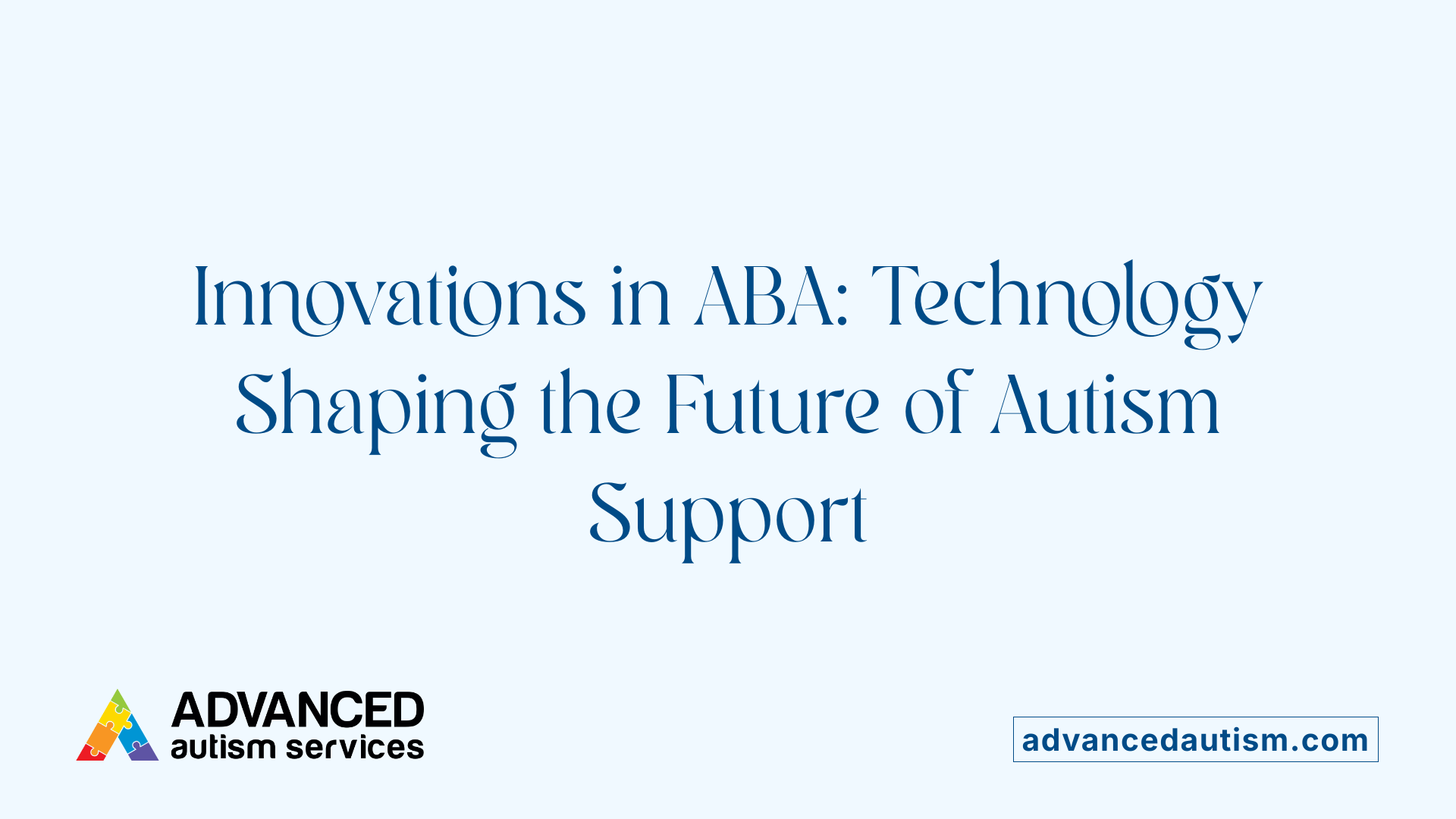Understanding the Role of ABA Therapy in Autism Support
Applied Behavior Analysis (ABA) therapy stands as a cornerstone in autism intervention, offering scientifically grounded strategies to foster skill development and behavioral management. As research and practice evolve, ABA therapy has demonstrated significant long-term benefits for individuals on the autism spectrum, touching upon cognitive, social, and emotional domains. This article explores how ABA therapy impacts lifelong outcomes, examining its principles, effectiveness, provider qualifications, and the evolving nature of this therapeutic approach.
Defining ABA Therapy and Its Role in Autism Support

What is Applied Behavior Analysis (ABA) therapy and how is it used to support individuals with autism?
Applied Behavior Analysis (ABA) therapy is a scientifically validated approach that uses principles of learning and behavior modification to assist individuals on the autism spectrum. By employing techniques such as positive reinforcement and task analysis, ABA focuses on enhancing communication, social skills, and daily living activities while reducing challenging behaviors.
ABA programs are carefully tailored to each individual's strengths, needs, and interests, ensuring personalized and effective interventions. Therapists often use naturalistic and play-based methods to encourage skill generalization beyond therapy sessions, making learning enjoyable and relevant.
This therapy is implemented in various settings, including homes, schools, and clinics. Early and intensive ABA interventions—usually starting around ages 3 to 4 and involving approximately 20 hours weekly—have demonstrated significant benefits in cognitive development, language, and socialization.
Research confirms the positive impact of early ABA treatment on adaptive behaviors and independence, although its effects vary based on the individual's initial language abilities and age. Continuous assessments allow therapists to adjust goals, promoting sustained development and improved quality of life for individuals with autism.
Who Delivers ABA Therapy? Qualifications and Expertise

Who typically provides ABA therapy and what qualifications do they have?
ABA therapy is delivered by a range of trained professionals specializing in behavioral science and autism support. The most common providers include:
- Board Certified Behavior Analysts (BCBAs): These are graduate-level clinicians who design and supervise ABA programs.
- Board Certified Assistant Behavior Analysts (BCaBAs): They assist BCBAs in program implementation under supervision.
- Registered Behavior Technicians (RBTs): These technician-level providers carry out daily therapy sessions under BCBA guidance.
- Doctoral-level Specialists (BCBA-D): Experts with advanced credentials focusing on research and complex cases.
Certification requirements and training
Providers must meet rigorous criteria set by the Behavior Analyst Certification Board (BACB). This includes completing specific educational coursework, supervised practicum hours, and passing comprehensive certification exams. These steps ensure expertise in behavior analysis principles and ethical autism intervention.
Ongoing education for providers
To maintain credentials, ABA providers engage in continuing education. This keeps them updated on emerging research, refined therapy techniques, and best practices. Such ongoing learning supports the delivery of high-quality, individualized care.
Ensuring qualified professionals in therapy delivery
Families and organizations can verify provider accreditation through BACB records and confirm active certification status. Collaboration among therapists, families, and support teams also helps monitor therapy effectiveness and provider competency.
| Provider Type | Education Level | Role in Therapy |
|---|---|---|
| Board Certified Behavior Analyst (BCBA) | Master’s/Doctorate | Designs, supervises, and customizes ABA programs |
| Board Certified Assistant Behavior Analyst (BCaBA) | Bachelor’s + supervision | Assists BCBAs; implements interventions |
| Registered Behavior Technician (RBT) | High school + RBT training | Directly delivers therapy sessions under supervision |
| BCBA-D (Doctoral Level) | Doctorate | Conducts advanced assessments and research |
Core Principles and Techniques Underpinning ABA Therapy

What are the core principles and techniques used in ABA therapy for autism?
Applied Behavior Analysis (ABA) therapy is rooted in the science of learning and behavior modification. It harnesses evidence-based principles to enhance socially important skills such as communication, social interactions, and everyday living.
Central to ABA are reinforcement strategies: positive reinforcement encourages the repetition of desired behaviors by providing rewards, while negative reinforcement removes unpleasant stimuli to promote behavior. These techniques increase the likelihood of beneficial behaviors emerging and establishing.
In teaching complex skills, ABA employs prompting, fading, and behavior chaining. Prompting offers support that guides the individual through a task; fading gradually removes these aids to foster independence; and behavior chaining breaks down multi-step tasks into manageable steps taught sequentially.
Visual modeling is another effective technique, using videos and visual cues to demonstrate behaviors for individuals to observe and imitate. This approach supports learning by making abstract concepts more concrete.
To address challenging behaviors, ABA uses methods like extinction, which reduces unwanted behaviors by withholding reinforcement; redirection, which shifts focus to more appropriate actions; and script fading, designed to diminish reliance on rehearsed language and encourage natural communication.
Overall, ABA's approach is highly individualized and data-driven, with therapists collecting continuous data to monitor progress and tailor interventions. This ensures that therapy remains responsive to each individual's unique needs, promoting meaningful and lasting behavior change.
Evaluating the Effectiveness of ABA Therapy on Autism Outcomes

How effective is ABA therapy in improving outcomes for individuals on the autism spectrum?
ABA therapy is a widely-supported, evidence-based method to aid individuals with autism spectrum disorder (ASD) in building important skills. Research shows ABA leads to notable gains in communication, social interaction, adaptive behavior, and daily living skills.
Evidence supporting ABA effectiveness
Studies report moderate improvements in intellectual functioning (standardized mean difference of 0.51) and small but positive effects on adaptive behavior (SMD of 0.37) after ABA-based interventions. Early and intensive treatment, often involving around 21-22 hours per week starting before age 4, tends to achieve the best outcomes. These gains foster enhanced participation and independence for children with ASD.
Impact on communication, social skills, and adaptive behavior
ABA therapy has demonstrated significant benefits in improving key areas such as communication, socialization, and self-care. Early intervention particularly boosts language and social skills for less severely impacted children. Long-term ABA involvement promotes emotional regulation, academic achievement, and broader social integration.
Long-term benefits and cognitive development
Beyond immediate skill acquisition, ABA supports cognitive growth involving problem-solving, critical thinking, and decision-making. Therapy aims to leverage individual strengths, encouraging autonomy without trying to alter inherent neurodiversity. Enhanced family dynamics often result from improved communication and collaboration.
Role of early and intensive intervention
Initiating ABA early in childhood combined with high-intensity therapy produces substantial developmental progress. Intensive programs lasting 1-3 years and averaging 20-40 hours weekly are linked with the greatest improvements, maximizing the potential to solidify foundational skills.
Limitations and variability in research quality
Despite promising outcomes, many primary studies have methodological limitations and heterogeneity, which may bias findings. Some outcomes show potential publication bias, and no significant impact has been firmly established for language abilities or parental stress compared to controls. Effectiveness often depends on factors such as the child’s initial language level and age at intervention.
In summary, ABA therapy remains a leading approach for enhancing developmental trajectories in children with autism. Continued research and personalized interventions will help refine treatment and maximize long-term benefits.
Family Involvement: A Critical Factor in Sustained Success
Importance of Family Collaboration
Family collaboration is foundational to the success of ABA therapy. When families actively participate in the therapeutic process, outcomes tend to improve substantially. This teamwork fosters a consistent learning environment that extends beyond therapy sessions.
Training and Support Systems for Families
Support for families includes training workshops, community support groups, and resources that empower them to reinforce skills at home. Continual training helps parents understand behavioral strategies and promotes confidence in managing day-to-day challenges related to autism.
Impact on Family Dynamics and Communication
ABA therapy's influence reaches beyond the individual with autism; it often improves family dynamics. Increased understanding and communication among family members encourage cooperation and decrease stress, building a supportive home environment conducive to learning.
Ongoing Communication with Therapists
Regular interaction between therapists and families is essential. Effective communication ensures that goals are aligned, progress is monitored, and adjustments are made proactively. This partnership supports consistent application of strategies and accelerates skill development.
Benefits of Parental Involvement in Therapy
When parents are involved, children benefit from more generalization of skills into daily life. Parental participation also strengthens emotional bonds and ensures therapy is tailored to a child’s unique interests and needs.
What considerations should families keep in mind when selecting an ABA therapy provider?
Families should look for providers with qualified and certified therapists (such as BCBA or RBT), who follow ethical guidelines and use evidence-based, personalized methods focused on positive reinforcement. It is important to evaluate the experience with autism, flexibility for different settings, and emphasis on family collaboration and transparent communication. Choosing a provider that respects the child’s well-being and fosters skill development is vital for meaningful, long-term success.
Modern ABA: Evolving Practices and Ethical Considerations
Shift from aversive methods to humane approaches
Originally, ABA therapy included aversive techniques such as electric shocks to reduce undesired behaviors. Today, this approach is widely rejected by professionals and advocates alike. Modern ABA centers on humane, positive reinforcement strategies that encourage skill development without causing distress or harm.
Play-based and naturalistic therapy
Current ABA practices emphasize play-based and naturalistic methods. Therapy sessions are designed to be engaging and fun, often incorporating activities that feel natural to the child's everyday environment. This approach helps children generalize learned skills beyond therapy into real life situations without the rigidity seen in older models.
Focus on child strengths and interests
Modern ABA prioritizes building on each child's unique strengths and interests. Therapists tailor interventions to celebrate individuality, helping children find joy and active participation within their environment. This personalized strategy promotes motivation and positive outcomes by respecting what the child enjoys and excels at.
Respecting neurodiversity and autonomy
Unlike earlier iterations, contemporary ABA therapy focuses on fostering independence and societal participation without attempting to alter the child's inherent neurodiversity. The goal is to support the child’s autonomy and help them navigate their world confidently, rather than enforcing conformity to neurotypical norms.
Critiques and responses from the ABA community
Critics argue that some ABA approaches have historically been overly demanding, repetitive, or focused on conformity, potentially suppressing natural autistic behaviors. In response, supporters emphasize that modern ABA is much more child-centered and personalized, designed to develop skills while respecting the individual's distinct characteristics and autonomy. This evolution reflects a broader commitment within the ABA community to ethical and compassionate practices.
Long-Term Behavioral and Cognitive Benefits of ABA Therapy
How Does ABA Therapy Improve Social Skills and Communication?
ABA therapy has been shown to significantly enhance social skills and communication in individuals with autism. Early and intensive interventions specifically support communication development, especially in children with higher initial language abilities. These improvements not only facilitate better interaction but also help individuals engage more effectively with their environment and peers.
In What Ways Does ABA Promote Independence and Daily Living Skills?
A core goal of ABA therapy is fostering independence by teaching essential life skills such as self-care, communication, and daily activities. This promotes participation in society and helps individuals with autism manage their day-to-day tasks more confidently, increasing their autonomy without attempting to alter inherent neurodiversity.
What Are the Emotional and Academic Outcomes Associated with ABA?
Long-term benefits include improved emotional regulation and enhanced academic achievement. Through behavior modification techniques and positive reinforcement, ABA helps individuals develop problem-solving and critical thinking skills that contribute to success in educational settings and emotional wellbeing.
Does ABA Therapy Support Skill Generalization Beyond Therapy Sessions?
Modern ABA approaches emphasize naturalistic and play-based methods that focus on the generalization of skills. Children are encouraged to apply learned behaviors in various real-world contexts, ensuring that gains made during therapy extend into everyday life.
What Does Research Say About Intellectual Functioning and Adaptive Behavior?
Meta-analyses indicate that comprehensive ABA interventions have a medium effect on intellectual functioning, with a standardized mean difference (SMD) of 0.51, and a small effect on adaptive behavior (SMD 0.37). These findings highlight ABA's role in promoting cognitive development and functional skills over time, although further rigorous studies are needed to corroborate these outcomes fully.
| Benefit Area | Description | Outcome Measures |
|---|---|---|
| Social Skills & Communication | Improved interaction and language abilities | Enhanced socialization |
| Independence & Daily Skills | Development of self-care and routine tasks | Increased autonomy |
| Emotional & Academic Growth | Better emotional regulation and academic skills | Improved problem-solving |
| Skill Generalization | Transfer of skills to natural environments | Sustainable behavior changes |
| Intellectual Functioning | Medium positive impact on intellectual capacity | SMD = 0.51 |
| Adaptive Behavior | Small positive impact on daily functioning | SMD = 0.37 |
Challenges and Limitations in ABA Research and Practice
Variability in Study Quality and Biases
Research on ABA therapy showcases a range of study qualities, with many primary studies showing generally low methodological rigor. This variability poses challenges in confidently interpreting results and calls for cautious advocacy based on existing evidence. Furthermore, publication bias and heterogeneity of outcomes affect the reliability and generalizability of research findings.
Impact of Initial Language Abilities and Age on Outcomes
The effectiveness of ABA seems to be influenced by individual characteristics, particularly a child's language abilities at the time of intake and their age. Children with stronger initial language skills often experience better treatment outcomes, highlighting the importance of tailoring interventions to each child’s starting point.
Limited Significant Impact on Some Domains
While ABA interventions positively affect intellectual functioning and adaptive behavior, evidence indicates little to no significant improvement in certain areas such as language abilities, severity of autism symptoms, or reductions in parental stress beyond what control groups show. These findings suggest that ABA therapy may need to be supplemented or adapted to address these domains more effectively.
Need for Rigorous Future Studies and Transparency
Given the methodological limitations and potential biases found in current research, a clear priority is to conduct more rigorous, transparent, and replicable studies. Such efforts will better clarify ABA’s effectiveness across diverse populations and settings and address inconsistent findings.
Real-World Approaches to Heterogeneity in Autistic Populations
Autistic individuals vary widely in abilities and needs. Addressing this diversity requires flexible, personalized approaches in ABA practice to maximize benefits. Real-world application must consider this heterogeneity, ensuring interventions are responsive rather than one-size-fits-all.
Overall, while ABA has documented benefits, these challenges urge careful interpretation and continuous improvement in research and practice to optimize outcomes for individuals on the autism spectrum.
Future Directions: Technological Innovations Enhancing ABA Therapy

How are AI, VR, and wearable devices being incorporated into ABA therapy?
Emerging technologies like Artificial Intelligence (AI), Virtual Reality (VR), and wearable devices are increasingly being integrated into ABA therapy to enrich interventions. AI can analyze individual behavior patterns and adapt therapy in real-time, creating personalized learning experiences. VR offers immersive environments that simulate social interactions or everyday scenarios, helping individuals practice skills in a safe and engaging setting. Wearable devices collect continuous data on physiological and behavioral responses, providing therapists with objective insights to tailor interventions more precisely.
What role does telehealth play in modern ABA therapy?
Telehealth has become an essential tool in delivering ABA therapy, especially for families in remote or underserved areas. It facilitates remote intervention delivery through video conferencing, allowing therapists to coach caregivers and supervise sessions without geographic constraints. This approach enhances accessibility and continuity of care, reducing barriers related to travel or scheduling. Telehealth also supports real-time feedback and adjustments, making therapy more responsive to the child's needs.
How do these technologies enable personalized and engaging therapy approaches?
By leveraging AI-driven analytics and VR environments, ABA therapy can be tailored to each child's unique strengths, challenges, and interests. Interactive and gamified elements promote motivation and sustained engagement, transforming traditional session formats into more naturalistic and fun experiences. These personalized methods foster generalization of skills beyond therapy sessions, encouraging participation and joy within everyday contexts.
In what ways might technology improve the accessibility and effectiveness of ABA therapy?
Technological tools reduce geographic and logistical barriers, providing wider access to high-quality ABA services. They enable data-driven decision-making by continuously tracking progress and adjusting interventions dynamically. This data-rich feedback loop can optimize therapy intensity and focus, potentially accelerating skill acquisition and behavioral improvements. Additionally, technology supports caregiver involvement through user-friendly interfaces and real-time communication with therapists, strengthening support systems.
What emerging tools assist with data tracking and adaptive programming?
Advanced wearable sensors and AI-powered software collect comprehensive behavioral and physiological data, allowing for fine-grained monitoring of responses to interventions. These tools support adaptive programming by identifying when modifications are needed and suggesting individualized strategies. As a result, therapy becomes more responsive and effective, aligning with contemporary goals of promoting independence, participation, and quality of life for individuals with autism.
Looking Ahead: The Continuing Impact of ABA Therapy
ABA therapy remains a dynamic and evolving approach integral to supporting individuals with autism throughout their lives. Its evidence-based principles have yielded significant gains in communication, behavior, and independence, profoundly influencing long-term outcomes. The increasing emphasis on ethical, child-centered practices—combined with active family collaboration and emerging technologies—promises to further enhance effectiveness and accessibility. Continuous research, practitioner expertise, and personalized intervention will be vital to maximizing ABA's potential in empowering individuals with autism to thrive in diverse settings and phases of life.
References
- The Long-Term Effects of ABA Therapy -
- The Controversy Around ABA
- The Future of ABA Therapy: Emerging Research & Long ...
- Comprehensive ABA-based interventions in the treatment of ...
- ABA Certification Explained: RBT, BCaBA, BCBA, BCBA-D
- How to Become an Applied Behavior Analyst (ABA) Therapist
- Applied Behavior Analysis (ABA)
- Applied Behavior Analysis (ABA)
- Applied Behavior Analysis in Children and Youth with Autism ...
- Applied Behavior Analysis (ABA) for Children With Autism



